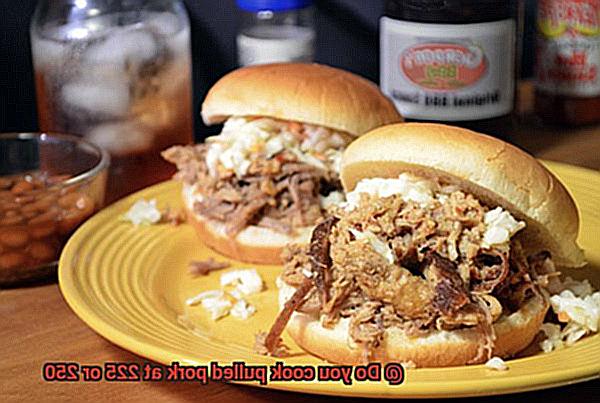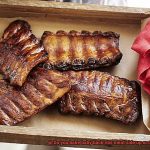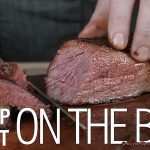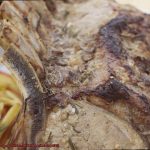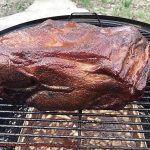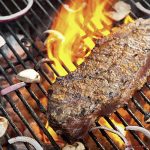Ready for a finger-licking adventure that’ll have your taste buds begging for more? Hold on tight, because today we’re cracking the code to achieving pulled pork perfection that’ll make your mouth water.
Among pitmasters and barbecue enthusiasts, there’s a sizzling debate about the ideal temperature for cooking pulled pork: should it be a low and slow 225 degrees Fahrenheit or a slightly hotter 250 degrees? It might seem like a trivial matter, but let me tell you, this decision can make or break your meat masterpiece.
In this all-inclusive guide, we’re diving deep into the science and art of creating mind-blowing pulled pork. We’ll carefully weigh the pros and cons of each temperature, so grab your apron and get ready to fire up that smoker as we uncover whether 225 or 250 degrees is the secret sauce to mouthwatering pulled pork.
Contents
What is Pulled Pork?
Pulled pork is a beloved dish that hails from the Southern United States. Made from pork shoulder or pork butt, which are both cuts of meat from the upper shoulder of the pig, pulled pork is a result of slow-cooking the meat until it becomes tender and easily shredded with a fork.
The process of cooking pulled pork involves low and slow cooking, which means it is cooked at a low temperature for an extended period. This allows the tough connective tissues in the meat to break down and become tender, resulting in juicy and flavorful pulled pork.
When it comes to cooking temperatures, there are two common options: 225°F and 250°F. Cooking at 225°F requires more time, typically around 1 to 1.5 hours per pound of meat. This slower cooking method allows for more collagen breakdown and yields extremely tender and moist pulled pork.
Cooking at a slightly higher temperature of 250°F will still produce delicious pulled pork but will take less time compared to cooking at 225°F. The higher temperature can result in a slightly more caramelized exterior on the meat, adding an extra layer of flavor.
The choice between cooking pulled pork at 225°F or 250°F depends on personal preference and available time. If you have the luxury of time and want maximum tenderness and flavor, opting for the lower temperature of 225°F is recommended. However, if you are pressed for time and still want to enjoy delicious pulled pork, cooking at 250°F can provide satisfactory results.
It’s important to monitor the internal temperature of the pork to ensure it is cooked safely. The USDA recommends cooking pork to at least 145°F internally, but for pulled pork’s desired tenderness, many pitmasters suggest cooking until the internal temperature reaches around 195°F to 205°F.
Factors such as the size and thickness of the pork cut, type of smoker or grill being used, and personal preferences for texture and taste can also influence the choice of cooking temperature.
Cooking Temperature for Pulled Pork – 225°F vs 250°F
Each temperature has its own merits and drawbacks, making the choice a matter of personal preference and convenience.
Cooking at 225°F allows for a lengthier cooking time, which is perfect for breaking down tough connective tissues and rendering the fat in the pork. This slow and steady approach results in a tender and flavorful final product that will have your taste buds dancing with joy.
Additionally, the lower temperature allows for more smoke absorption, infusing the pork with a rich and smoky essence that will transport you straight to barbecue heaven. However, cooking at 225°F requires patience as it takes longer to reach the desired level of doneness.
On the other hand, cooking at 250°F can shave off some precious cooking time, making it a more convenient option for those who are pressed for time or simply cannot wait to sink their teeth into succulent pulled pork. The higher temperature can also produce a slightly crisper bark on the outside of the pork, adding an extra layer of texture that some barbecue aficionados crave. However, this method may sacrifice a bit of tenderness and smoke flavor compared to pork cooked at 225°F.
To achieve pulled pork perfection at either temperature, here are some expert tips:
- Utilize a trusty meat thermometer to keep a close eye on the internal temperature of the pork.
- For both temperatures, aim for an internal temperature between 195°F and 205°F to reach the pinnacle of succulence.
- When cooking at 225°F, be prepared for a longer cooking time to allow the magic of tenderizing to work its wonders.
- When cooking at 250°F, exercise vigilance over the pork’s exterior to prevent it from becoming overly crispy or worse, burnt.
- Regardless of the chosen temperature, employ a flavorful rub or marinade to elevate the taste of the pork to new heights.
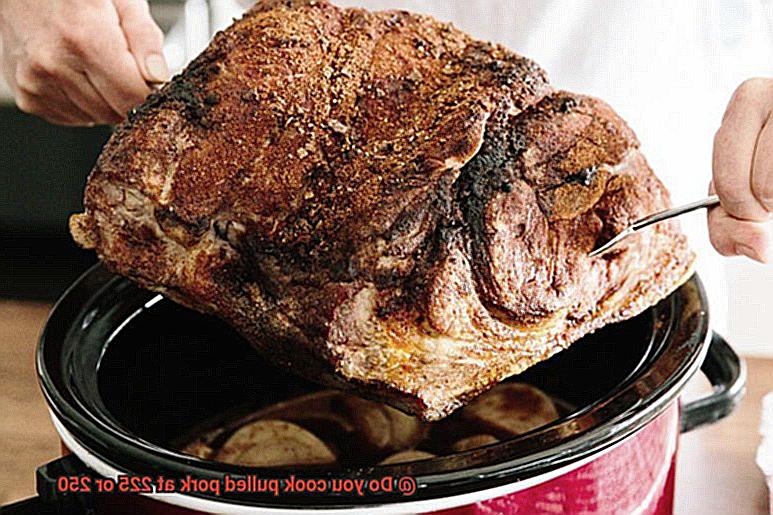
Ultimately, the choice between 225°F and 250°F hinges on your personal preferences and time constraints. If you revel in the slow cooking process and crave maximum tenderness and smoke flavor, embrace the allure of 225°F. However, if you seek a quicker cook time or relish a slightly crisper exterior, embrace the boldness of 250°F.
Benefits of Cooking Pulled Pork at 225°F
When it comes to cooking pulled pork, there is a fiery debate about the ideal temperature. Some swear by cooking it at 250°F, claiming that it results in a quicker cook time and a slightly crispier exterior. However, there are numerous benefits to slow-cooking pulled pork at 225°F that cannot be ignored.
Perhaps the most notable advantage of cooking pulled pork at 225°F is the slow and low cooking process. This temperature allows for a gradual breakdown of the tough connective tissues in the pork shoulder or butt, resulting in a tender and flavorful end product. Picture this: succulent, melt-in-your-mouth pulled pork that practically falls apart with each forkful.
The lower temperature of 225°F also ensures that the pork cooks evenly and retains its moisture. Higher temperatures can cause the exterior to cook too quickly, leading to dry and tough meat. By cooking at 225°F, you can achieve a moist and juicy pulled pork every single time, without fail.
Now, let’s talk about the smoke. If you’re using a smoker or adding wood chips to your grill, cooking at 225°F allows for more smoke absorption. The slower cooking process provides ample time for the meat to soak up that delicious smoky flavor, infusing every bite with a tantalizing aroma that will leave your taste buds dancing.
Moreover, cooking at 225°F gives you more control over the entire cooking process. You can monitor the internal temperature of the pork more accurately, ensuring that it reaches the desired doneness without overcooking. It’s like being the conductor of an orchestra, orchestrating the perfect symphony of flavors.
And here’s the cherry on top: cooking at 225°F is more forgiving if you happen to slightly overshoot the recommended internal temperature. The lower heat allows for a longer window of time before the meat becomes dry or overcooked, giving you some much-needed wiggle room to make adjustments and still end up with a mouthwatering masterpiece.
Benefits of Cooking Pulled Pork at 250°F
Cooking pulled pork at 250°F offers a range of benefits that result in a mouthwatering and delicious end product.
First and foremost, cooking pulled pork at 250°F allows for a faster cooking time compared to lower temperatures like 225°F. This is particularly advantageous when time is limited, such as when you’re hosting a barbecue or feeding a large group of people. The higher heat helps to cook the pork more quickly, ensuring that it reaches the desired level of tenderness in a shorter amount of time.
Speaking of tenderness, cooking pulled pork at 250°F helps to achieve a tender and juicy meat that will have your taste buds dancing with joy. The higher temperature breaks down the collagen in the pork shoulder more quickly, converting it into gelatin. This process adds richness to the meat and ensures that each bite is packed with flavor.
But it’s not just about tenderness; cooking at 250°F also creates a flavorful crust or bark on the outside of the pork. The higher heat promotes better caramelization and browning, resulting in a beautifully golden and deliciously crispy exterior. This crust locks in the moisture inside the meat, ensuring that every bite is succulent and bursting with flavor.
Another benefit of cooking pulled pork at 250°F is the reduction in fat content. The higher heat helps to render out excess fat from the pork, resulting in a leaner and less greasy final product. This is particularly beneficial for those who prefer a leaner pulled pork or are watching their fat intake.
Furthermore, cooking at 250°F offers versatility in cooking methods. Whether you prefer direct grilling or smoking techniques, this temperature allows for a range of options to add smoky flavors to your pulled pork. The higher heat ensures that the meat absorbs those delicious smoky flavors while maintaining its tenderness and juiciness.
Last but certainly not least, cooking at 250°F helps achieve a desirable texture for pulled pork. The higher heat creates strands of meat that easily separate and shred with minimal effort. This means that you’ll spend less time wrestling with the meat and more time enjoying your perfectly pulled pork.
Factors to Consider When Choosing a Temperature for Pulled Pork
The temperature at which you cook your pork can have a significant impact on various factors such as cooking time, texture, bark development, fuel efficiency, and personal preference. Let’s delve into these factors to help you make an informed decision.
- Time: Time availability plays a vital role in determining the temperature for cooking pulled pork. If you have ample time on your hands and want to achieve that melt-in-your-mouth tenderness, cooking at a lower temperature, around 225 degrees Fahrenheit, is ideal. This slow and low method breaks down the collagen in the meat gradually, resulting in succulent and juicy pork. On the other hand, if you’re short on time or simply can’t wait to savor the deliciousness of pulled pork, cooking at a higher temperature, around 250 degrees Fahrenheit, will significantly reduce the cooking time.
- Texture: The texture of your pulled pork is another critical factor to consider. Cooking at a lower temperature for a longer period of time will give you meat that effortlessly shreds apart, offering a melt-in-your-mouth experience. The collagen breaks down slowly during this process, resulting in tender and succulent pork. Conversely, cooking at a higher temperature will yield firmer meat with more bite. This can be preferred by individuals who enjoy a little more texture in their pulled pork.
- Bark Development: The outer layer of the pulled pork, known as the bark, adds depth and complexity to its flavor profile. Cooking at a lower temperature allows for more time for the bark to develop a deep smoky flavor and a crispy exterior. The slow cooking process allows for ample rendering of fat, contributing to the formation of a beautiful crust. On the other hand, cooking at a higher temperature may not provide sufficient time for the bark to fully develop, resulting in a less pronounced flavor and texture.
- Fuel Efficiency: For those who are mindful of fuel consumption or want to extend their smoking session without constantly refilling charcoal or wood chips, fuel efficiency is a crucial consideration. Cooking at 225 degrees Fahrenheit requires less fuel compared to cooking at 250 degrees Fahrenheit. The longer cooking time at the lower temperature allows for a slower burn, making it a more economical option.
- Personal Preference: Ultimately, the choice between cooking at 225 or 250 degrees Fahrenheit for pulled pork boils down to personal preference. Both temperatures can produce mouthwatering results; it’s just a matter of what factors are most important to you. If you prioritize tenderness and have the luxury of time, low and slow cooking at 225 degrees Fahrenheit is an excellent choice. On the other hand, if you prefer a firmer texture and shorter cooking time, 250 degrees Fahrenheit might be more suitable. Experimentation with both temperatures will help you discover your own perfect balance.
Monitoring Internal Temperature of the Pork
Monitoring the internal temperature of pork is not just a matter of guesswork or intuition. It is an art that requires precision and attention to detail. To achieve the perfect pulled pork, follow these steps and ensure that your meat is cooked to perfection.
First, prepare your grill or smoker. This means preheating it and setting it to the desired temperature range of 225°F to 250°F. This provides the ideal cooking environment for your pork, creating a tender and juicy end product.
Next, insert the meat thermometer probe into the thickest part of the pork. Make sure the probe isn’t touching any bone, as this can lead to inaccurate readings. The thermometer becomes your trusted companion throughout the cooking process, allowing you to monitor the temperature closely.
To ensure accuracy, check multiple areas of the pork. Insert the probe into different parts of the meat, avoiding any bone. Take note of the readings from each area. This ensures even cooking and guarantees that all parts of the pork are perfectly done.
Resist the temptation to open the grill or smoker excessively. Every time you do so, you risk temperature fluctuations and extended cooking time. Instead, rely on your thermometer readings to determine when your pork is done.
Determining doneness is crucial. The recommended internal temperature for pulled pork is between 195°F and 205°F. When your meat reaches this range, it should be tender and easy to pull apart. Trust your thermometer to guide you to this moment of succulent perfection.
Once you’ve reached your desired internal temperature, it’s time for a resting period. Remove the pork from the grill or smoker and let it rest for about 15-30 minutes. During this time, the juices redistribute throughout the meat, resulting in a more flavorful and moist end product.
Tips and Tricks for Cooking Perfectly Tender Pulled Pork
Pulled pork is a delicious dish that can be enjoyed on its own or in sandwiches, tacos, and more. The key to cooking perfectly tender pulled pork lies in the cooking method and temperature. Here are some tips and tricks to help you achieve the best results:
Cook Low and Slow
The secret to tender pulled pork is cooking it at a low temperature for a long period of time. This allows the collagen in the meat to break down and become tender. The recommended temperature range is between 225°F and 250°F.
To achieve this low and slow cooking, use a charcoal or pellet smoker, which can help maintain a steady temperature throughout the cooking process. This gradual breakdown of collagen ensures that the pork becomes tender and juicy, resulting in melt-in-your-mouth pulled pork.
Use a Meat Thermometer
To ensure that your pulled pork is cooked to perfection, use a meat thermometer to monitor the internal temperature. The ideal range for pulled pork is around 195°F to 205°F. This ensures that the collagen has broken down completely, resulting in tender and juicy meat.
Insert the meat thermometer into the thickest part of the pork, avoiding contact with any bone. By monitoring the temperature throughout the cooking process, you can ensure that your pulled pork is cooked to perfection every time.
Enhance Flavor with Rubs or Marinades
Before cooking, consider using a dry rub or marinade to enhance the flavor of your pulled pork. A dry rub typically consists of a combination of spices, herbs, and sugar that is applied to the meat before cooking. This creates a flavorful crust on the outside of the pork.
For maximum flavor infusion, apply the dry rub or marinade to the pork and let it sit in the refrigerator for at least 4 hours or overnight. This will allow the flavors to penetrate deep into the meat, resulting in a flavorful and tender pulled pork.
Let it Rest
After cooking, allow the pork to rest for about 30 minutes before shredding. This allows the juices to redistribute throughout the meat, resulting in a more flavorful and moist final product. Simply wrap the cooked pork in foil and let it rest.
During the resting period, the residual heat will continue to cook the pork slightly, while the juices will redistribute, ensuring that each bite is juicy and succulent. This resting period is crucial for achieving the perfect texture and flavor in your pulled pork.
Shred Properly
Shredding the pork properly is key to achieving that classic pulled pork texture. Once the pork has rested, use two forks or your hands to pull it apart into small shreds. Be sure to remove any excess fat or connective tissue as you shred.
To achieve perfectly shredded pork, hold one fork steady and use the other fork or your fingers to pull the meat apart along the natural grain of the muscle fibers. This will result in tender and succulent shreds of pulled pork that are easy to eat and full of flavor.
rgPJxy_IngY” >
Conclusion
When it comes to cooking pulled pork, the debate between 225 and 250 degrees Fahrenheit is a hot topic. Some swear by the low and slow method at 225 degrees, claiming it results in tender and juicy meat. Others prefer the slightly higher temperature of 250 degrees, arguing that it cooks faster without sacrificing flavor.
But here’s the thing: there’s no one-size-fits-all answer. The ideal cooking temperature for pulled pork depends on your personal preference and time constraints.
Cooking at 225 degrees allows the collagen in the meat to slowly break down over a longer period of time, resulting in incredibly tender pork that practically melts in your mouth. It requires patience and dedication but can be well worth the wait.
On the other hand, cooking at 250 degrees can shave off some cooking time while still producing delicious results. The slightly higher heat helps render the fat more efficiently, creating a flavorful crust on the outside while keeping the inside moist and succulent.
So whether you choose to cook your pulled pork at 225 or 250 degrees, what truly matters is giving it enough time to reach its desired tenderness. This means using a meat thermometer to ensure it reaches an internal temperature of around 195-205 degrees Fahrenheit.
In conclusion, there’s no definitive answer to whether you should cook pulled pork at 225 or 250 degrees. It ultimately boils down to personal preference and how much time you have on hand. Whichever temperature you choose, make sure to monitor your meat closely and let it rest before pulling apart those delectable strands of porky goodness.
Remember, cooking is an art form that allows for experimentation and adaptation.

